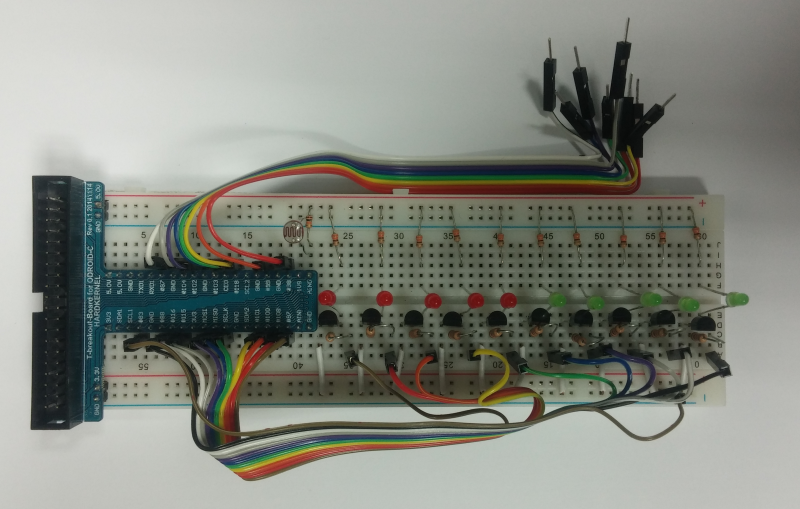Table of Contents
Introduction
You're probably itching to make some fun embedded computer projects with ODROID-XU4. What you need is an add on prototyping T-breakout board, which can break out all those tasty power, GPIO, I2C, ADC pins from the 40 pin header onto a solderless breadboard. This set will make “cobbling together” prototypes with the ODROID-XU4 super easy.
This kit comes with below many items.
- Assembled T-breakout PCB - 40Pin GPIO Breakout board
- Breadboard - 630 Tie-points with dual power lanes
- 40pin Ribbon cable - IDC Flat cable 100mm
- 40pin Male-to-Male Dupont jumper Wire 170mm
- 7 x Green LED 3mm
- 7 x Yellow LED 3mm
- 7 x Red LED 3mm
- 2 x Photo Cell (CdS Light sensor)
- 6 x Tact Switchs
- 50 x 330 Ohm 1/6W resister
- 50 x 10K Ohm 1/6W resister
DIY light level meter project
Linux
1. Configuration tinkering kit such as below schematic.
Light Level Meter schematic
2. Get the wiringPi library compatible ODROID
# git clone https://github.com/hardkernel/wiringPi
3. Build the library
# cd wiringPi # ./build
4. Compile and run the example source code.
- example-led.c
//------------------------------------------------------------------------------------------------------------ // // ODROID-C GPIO(LED) / ADC Test Application. // // Defined port number is wiringPi port number. // // Compile : gcc -o <create excute file name> <source file name> -lwiringPi -lwiringPiDev -lpthread // Run : sudo ./<created excute file name> // //------------------------------------------------------------------------------------------------------------ #include <stdio.h> #include <stdlib.h> #include <stdint.h> #include <unistd.h> #include <string.h> #include <time.h> #include <wiringPi.h> #include <wiringPiI2C.h> #include <wiringSerial.h> #include <lcd.h> //------------------------------------------------------------------------------------------------------------ // // Global handle Define // //------------------------------------------------------------------------------------------------------------ #define DATA_UPDATE_PERIOD 100 // 100ms //------------------------------------------------------------------------------------------------------------ // // ADC: // //------------------------------------------------------------------------------------------------------------ #define PORT_ADC 0 // ADC.AIN0 #define MAX_ADC_VALUE 4095 //------------------------------------------------------------------------------------------------------------ // // LED: // //------------------------------------------------------------------------------------------------------------ const int ledPorts[] = { 7, 0, 2, 3, 12, 13, 14, 21, 22, 23, }; #define MAX_LED_CNT (sizeof(ledPorts) / sizeof(ledPorts[0])) #define ADC_UNIT (MAX_ADC_VALUE / MAX_LED_CNT) //------------------------------------------------------------------------------------------------------------ //------------------------------------------------------------------------------------------------------------ // // system init // //------------------------------------------------------------------------------------------------------------ int system_init(void) { int i; // GPIO Init(LED Port ALL Output) for(i = 0; i < MAX_LED_CNT; i++) pinMode (ledPorts[i], OUTPUT); return 0; } //------------------------------------------------------------------------------------------------------------ // // board data update // //------------------------------------------------------------------------------------------------------------ void boardDataUpdate(void) { int i, adcValue, ledPos; // adc value read if((adcValue = analogRead (PORT_ADC))) { ledPos = adcValue / ADC_UNIT; } else ledPos = 0; // LED Control for(i = 0; i < MAX_LED_CNT; i++) digitalWrite (ledPorts[i], 0); // LED All Clear for(i = 0; i < ledPos; i++) digitalWrite (ledPorts[i], 1); // LED On } //------------------------------------------------------------------------------------------------------------ // // Start Program // //------------------------------------------------------------------------------------------------------------ int main (int argc, char *argv[]) { static int timer = 0 ; wiringPiSetup (); if (system_init() < 0) { fprintf (stderr, "%s: System Init failed\n", __func__); return -1; } for(;;) { usleep(100000); if (millis () < timer) continue ; timer = millis () + DATA_UPDATE_PERIOD; // All Data update boardDataUpdate(); } return 0 ; }
Python example
0. Requrements install
# sudo apt update # sudo apt install python-dev python-setuptools swig3.0
1. Get/setup WiringPi 2 for Python repository
# git clone https://github.com/hardkernel/WiringPi2-Python.git # cd WiringPi2-Python # git submodule init # git submodule update
2. Build & install
# ./build.sh
Or
# swig3.0 -python -threads wiringpi.i # sudo python setup.py build install
3. Run the example source code
- example-led.py
#!/usr/bin/python import wiringpi2 as wpi import time leds = [7, 0, 2, 3, 12, 13, 14, 21, 22, 23] wpi.wiringPiSetup() # GPOI pin setup for x in leds: wpi.pinMode(x, 1) wpi.digitalWrite(x, 0) adc_unit = 4095 / len(leds) while True: time.sleep(0.05) adcValue = wpi.analogRead(0) ledPos = adcValue / adc_unit for x in leds: wpi.digitalWrite(x, 0) for x in xrange(ledPos): wpi.digitalWrite(leds[x], 1)


